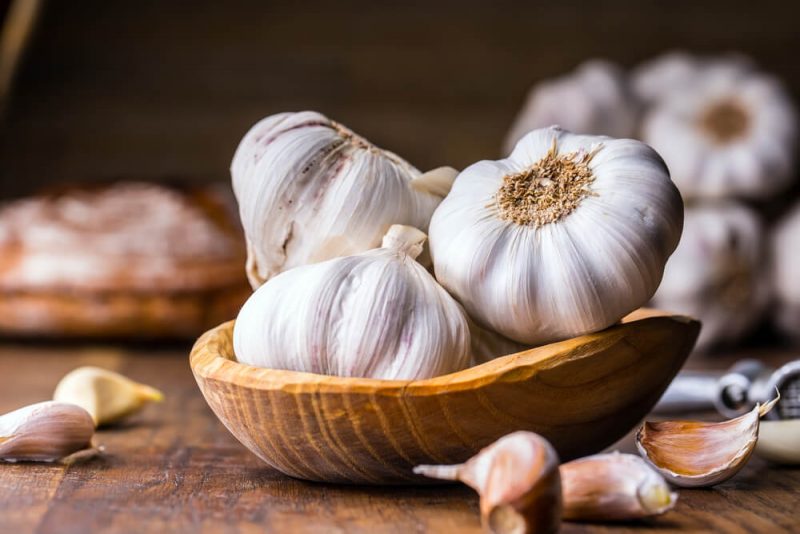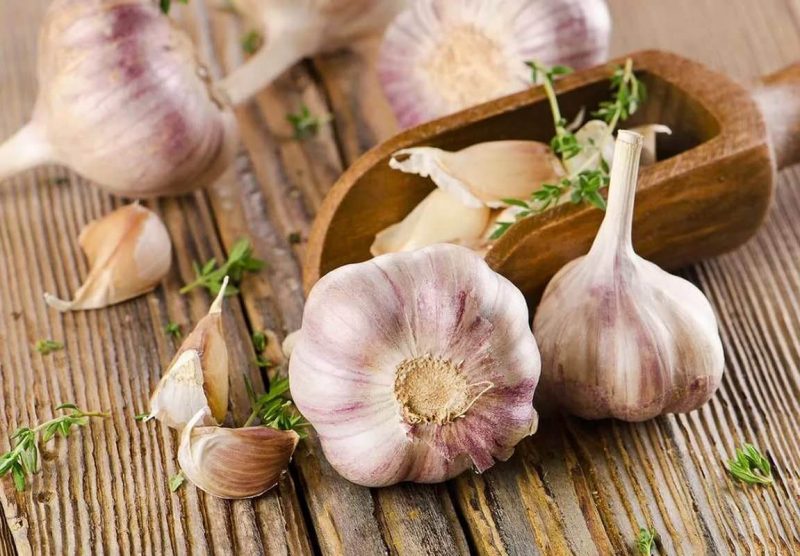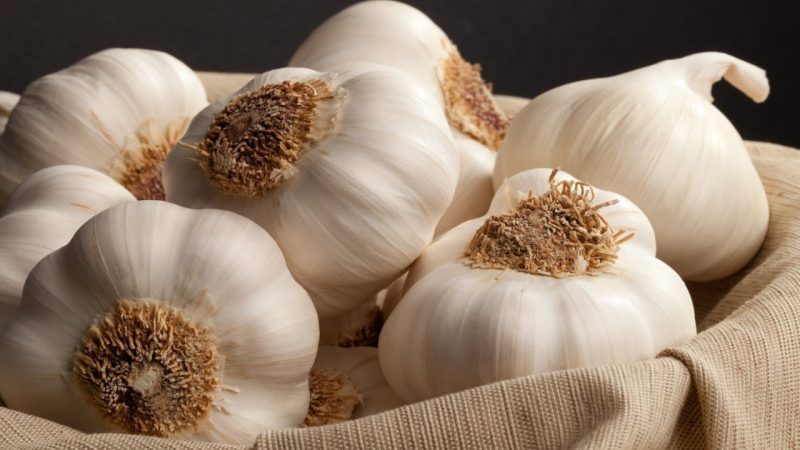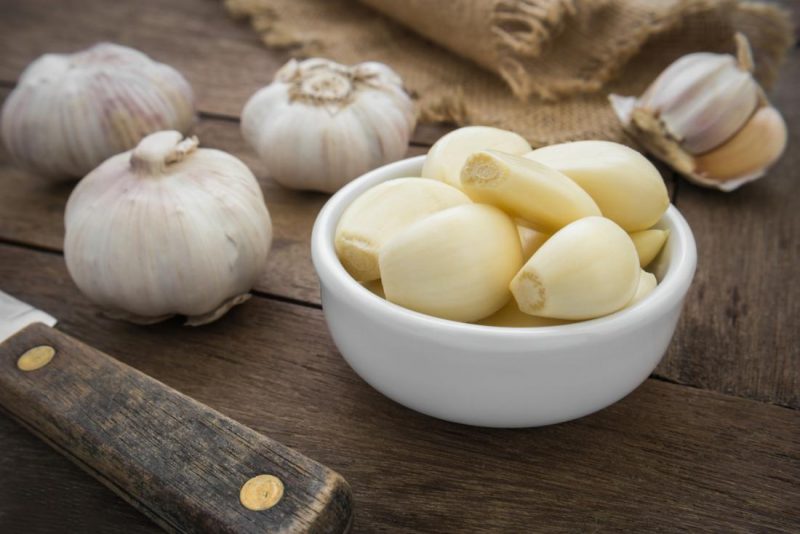Garlic is an important ingredient in many appetizers, soups, vegetable stews, cereals, salads and sauces. He gives them a pleasant aroma, pungency and piquancy, so the kitchen can not do without it. Knowing how to store garlic, you can save it in its original form for the whole winter and use it on the menu all year round.
Material Content:
Preparing garlic for long-term storage
The intricacies of preparing garlic for storage should be considered even during the harvest period.

There are several varieties of garlic, so you need to understand the timing and characteristics of each of them:
- Spring or summer. Harvested in the first half of August, when the leaves turn completely yellow and begin to lay down on the ground. It can be stored even until the next harvest.
- Winter. It reaches maturity in mid-summer, when the leaves begin to turn yellow, the scales become thinner and the skin of inflorescences crack. It is stored at low temperatures.
It is very important not to miss the digging period: if the heads break up into cloves, then they are no longer suitable for long-term storage. Ideal for storage, the bulb is dry, hard, has 3-4 layers of protective husk, and the slices are well separated from each other. Wet husks are a sign that the crop is not yet ready for harvesting.
Harvesting should be carried out only in dry weather, in the morning or evening hours. When digging out, be careful not to damage the heads with the tip of a shovel or pitchfork. Damaged garlic is not suitable for long-term storage.
Harvested crops must be dried under a canopy.If the heads are planned to be stored in braids, then the stems are not cut. In all other cases, the stems should be cut with sharp scissors at a distance of 1.5 cm from the beginning of the neck, and the roots should be removed with a pruner. In no case should you leave shrunken, damaged, diseased heads.

If part of the harvest is not suitable for long-term storage, do not get upset. Such heads can be chopped, dried, or frozen. Garlic, harvested in this form, is very convenient to use, but it loses a little in taste, since freezing affects both the taste and the consistency of the product. It is better to freeze garlic in crushed form and in small portions. It is advisable to store such blanks in two bags, otherwise the products in the freezer will acquire a characteristic odor.
Processing with a special solution gives a good result: add 10 drops of iodine to a half liter of calcined vegetable oil and dip each head into it. After that, the processed crop can be saved in any convenient way.
Optimal storage conditions
How to store garlic so that it does not dry out? It is best stored in a cold place. The temperature should vary from +3 to +5. If the crop is folded in a warm place, this will lead to drying out of the heads and their damage.
Optimum humidity should not exceed 80%. But excessive dryness is also harmful, as the heads begin to dry out. Therefore, you need to know how to store garlic so that it does not dry out and does not rot. Observing these conditions, you can save the collected raw materials in private buildings in the pantry, basement, attic and even in the apartment.

A prerequisite is a dark place. When light enters, the cloves begin to sprout.
Periodically harvested crops need to be reviewed in order to remove rotten bulbs in time. Their presence is very easy to determine by the characteristic unpleasant odor. Damage to the heads occurs due to infection by the fungus and non-compliance with storage requirements.
Ways to store garlic at home
Garlic can be stored not only separately, but also with onions in small rag bags, wooden boxes and cardboard boxes. If the crop is planned to be stored in the cellar, you need to take care of good ventilation. The constant circulation of fresh air is the key to the successful storage of the entire crop.
In glass jars or boxes
It’s pretty convenient to store garlic in a jar. Selected heads must be disassembled into slices and dried in the room. Then put in a container and, without clogging, leave in a dry room.
Boxes made of wood or plywood are the most popular containers for storage. The main thing is that they have openings for air circulation.
Refrigerator storage rules
Garlic is stored very well in the refrigerator. The only negative is that there is often no free space in it. Dry selected heads and transfer to paper bags. If there is excess salt or dry onion peel, it can also be added inside, this improves the quality of storage.
In salt
Many positive reviews are heard about the method of storage in salt. Salt should be poured into the bottom of the plywood containers, then one layer of sorted and dried heads should be laid out. It is necessary to ensure that they do not have common ground among themselves. The previous layer is laid out only after backfilling with the salt of the previous one. In one box, you can store no more than 5 layers of garlic. Instead of boxes, you can take glass containers, but this is not so convenient.
Garlic mass through a meat grinder
This method is most often used at the first sign of damage. The rotted or overdried slices must be discarded, and the remaining slices should be cleaned and passed through a meat grinder. Season the garlic mass with salt, mix, transfer to jars and clog. Keep refrigerated.
Purified Storage Technology

Peeled garlic is very convenient to use during cooking, since you do not need to spend time on peeling. It’s just that for a long time it will not even stand in the refrigerator.It is best to transfer the peeled slices into a glass container and pour in vegetable oil. Alternatively, garlic can be folded into pre-sterilized jars, covered with a lid and put in a cold place. But the shelf life of such a product is too short.
How to keep garlic in oil?
This method is good because in addition to a well-preserved product, you can also get aromatic garlic oil as a bonus. The peeled slices are tightly folded in a jar, periodically adding oil. Store in a cool place with a sealed lid.
Sometimes, instead of oil, dry white or red wine, wine or table vinegar is used.
In linen bags

Such bags can be sewn from old clothes and scraps of unnecessary fabric. The main thing is to dip the finished products in a strong saline solution and dry thoroughly. Salt, impregnated with tissue, does not allow pathogenic microbes to penetrate inside, so garlic does not deteriorate.
In braids and bunches
In braids and bunches, only summer garlic can be stored. This old way of storage was often used by our grandmothers and great-grandmothers. In old photographs and paintings, you can see real garlic garlands that hang on walls or beams.
For strength, use a rope or twine, making a loop at the end for easy hanging.
To weave a braid, you need a lot of skill, but it takes up little space, which is very convenient in a city apartment. It’s easier to tie the heads with stems into bundles and just hang them in a dry room.
If you don’t want to bother with bundles and braids, you can fold the heads into old nylon stockings or tights and hang them in a secluded place.
Unusual method - waxing
This method is rarely used, but its effectiveness is quite high. Previously, it was constantly used in vegetable stores before sending raw materials to the market or to the store. The heads in paraffin can be stored for at least 6 months in its original form, as this substance does not allow moisture to evaporate. Prepared quality heads are dipped in liquid paraffin, left to solidify and transferred to a suitable container.
In flour

Alternatively, you can store the heads in glass jars with flour. Garlic loosely stacked in containers with the roots down and sprinkled with plenty. Corking is not necessary.
Sprinkling garlic with fresh sawdust
The storage of vegetables and root crops in sawdust is a well-known method. It is best to use coniferous sawdust and wooden crates. Keep heads covered with sawdust in a cold and dry room.
Storage time

Correctly storing garlic in the winter is not difficult at all, but you need to consider that, depending on the method, the shelf life varies:
- The longest garlic is stored in paraffin and other loose dry foods. The same applies to linen bags, if they are lying in a dry room. Subject to all the rules, the product will retain its properties for six months.
- Next comes the garlic in the refrigerator, oil and a jar. The maximum shelf life is 3 months.
- The crushed garlic mass with salt is suitable for use no more than 8 weeks.
It should be borne in mind that summer garlic is stored better, and winter should be used first.
A large crop is best stored in several ways. This will prevent the loss of garlic in cases when suddenly some storage conditions are not met.












